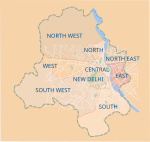Vasant Valley School
1990 establishments in DelhiEducational institutions established in 1990Schools in DelhiUse Indian English from September 2018Wikipedia semi-protected pages
Vasant Valley School is a co-educational private high school in Vasant Kunj, Delhi, India. After its inception, the school accepted students in July 1990, up to grade 4. The school added a new grade each year as the classes graduated to the next level. The first graduating class of Vasant Valley completed 12 grades under the CBSE syllabus in May 1999. The school began with Arun Kapur as its Director, a former housemaster at The Doon School and an alumnus of St. Stephen's College, Delhi.
Excerpt from the Wikipedia article Vasant Valley School (License: CC BY-SA 3.0, Authors).Vasant Valley School
Abdul Gaffar Khan Marg, New Delhi Vasant Kunj (Vasant Vihar Tehsil)
Geographical coordinates (GPS) Address External links Nearby Places Show on map
Geographical coordinates (GPS)
| Latitude | Longitude |
|---|---|
| N 28.5334 ° | E 77.1441 ° |
Address
Vasant Valley School
Abdul Gaffar Khan Marg
110037 New Delhi, Vasant Kunj (Vasant Vihar Tehsil)
Delhi, India
Open on Google Maps



